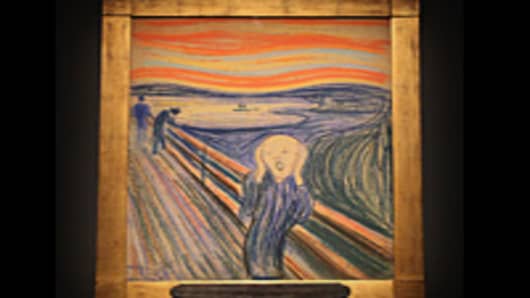Marron thinks private collectors will steer clear. “Most collectors like to remain anonymous,” he says. “Buy a painting like 'The Scream' and you automatically have to live with the notoriety and publicity.” Marron has talked to several friends who are “capable of buying it outright, today,” he says. “Whether they want to is another question.”
One financier and art collector who could surprise Marron is SAC Capital CEO Steven A. Cohen. The owner of an estimated half a billion dollars worth of art, Cohen set a record for a Munch work in 1999, when he bought the artist’s “Madonna” for $11.5 million. Sources close to Sotheby’s say the house recently arranged a private viewing of “The Scream” forCohen before it went on the block.
Apollo Global Management CEO Leon Black, a Metropolitan Museum of Art trustee who recently gave nearly $50 million to Dartmouth College for a new arts center, focuses on classical and Renaissance art. But like his very successful moves in the financial markets, Black is not above making bold bids at auction, once paying $47.6 million for a chalk drawing of a woman by Raphael.
RWL Water CEO Ron Lauder says there are three levels of art for passionate collectors: “There’s the ‘Oh,’ ‘Oh my,’ and ‘Oh. My. God’.” You want to go buy the ‘Oh. My. God'." Lauder knows from “Oh. My. God,” paying $135 million for Gustav Klimt’s portrait of Adele Bloch-Bauer in 2006.
Lauder, who calls himself an art collector, not an investor, compares the art world to the stock market. “People who look at art as an investment lose,” Lauder says. “Just like the stock market. There are many stocks, but you have to have a passion for it. You have to believe in it.”
American collectors will be competing with a new crop of buyers from overseas, according to Amy Cappellazzo, deputy chairman of Christie’s. “They are from Russia, the Middle East and parts of South America. China is rising. We see a market where buyers are extremely smart. Even the newer buyers are quick to learn, very quick to get good advice. We’re seeing an absolute robust, even intrepid, art market.”
Meanwhile at Christie’s on Tuesday night, a rare watercolor study, “The Card Players,” by the French post-impressionist Paul Cezanne sold for more than $19 million. The winning bidder, described by The Wall Street Journal as “a bespeckled man seated in the second row,” was glued to his cellphone as he bid, suggesting he represented a remote buyer. Christie’s is selling 32 works, including “The Peonies” by Henri Matisse, which could raise between $100 million to $150 million this week.
While Impressionists and Expressionists are making the big news this week, works by the contemporary German artist Gerhard Richter are also on the block this week. Richter has proved to be one of the most popular artists among Silicon Valley collectors like legendary venture capitalist Jim Breyer of Accel Partners. An early investor in Facebook, Breyer is a passionate contemporary art collector. He sits on the board of the San Francisco Museum of Modern Art and often posts pictures of his favorites to his Facebook page.
Whether or not one of these financiers walks away with “The Scream,” their influence will be felt. Before Christie’s spring sale last year, Boston Properties chairman and avid art collector Mort Zuckerman, upon observing an Andy Warhol self-portrait, told Power Lunch that the painting would fetch double its $20 million estimate.
When the final hammer fell after one of the longest bidding wars in history, the painting had gone for just over $38 million, to an unnamed American living in Europe. Christie’s said Zuckerman’s endorsement “definitely helped in raising its profile.”


